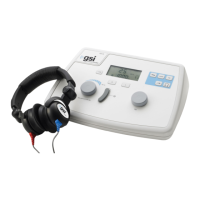GSI 18
Earphone cords
With extended use, earphone cords tend to fray internally at the junctions of both earphone
and audiometer connectors. This fraying will ultimately decrease the signal level in the
associated earphone or cause signals to be intermittent as the cord is flexed.
To check for either condition:
1. Set the Audiometer frequency control to 1000 or 2000 Hz.
2. Set the HL knob at a comfortable audible level and use a Steady Tone type.
3. Press the Present bar and flex earphone cord next to plug at both ends, listening for
intermittent signal, abrupt changes in signal level, or a scratchy sound superimposed over
the signal that coincides with the flexing of the cord. The presence of any of these three
conditions signifies that the cord should be replaced.
Hum and random noise
With the instrument set on 1000 Hz, move the HL knob from 0 to 60 dB and listen for low-
frequency hum and random noise (hiss or low rushing sound) at all attenuator levels. Some
audible random noise at levels above 60 dB is permissible. Below 60 dB, however, only the
signal should be audible. Any of these noises can be confused with the signal by naive
subjects and affect the accuracy of the audiogram. Schedule the audiometer for immediate
service if any audible hum or noise is detected.
Distortion and frequency shift
This check can be best made by listening to the output of the GSI 18 through the earphones
while presenting all 11 frequencies at a loud, but not uncomfortable, level (70 to 80 dB HL for
normal ears).
Listen for rattling, rasping or distortion in the tones presented. Listen also to verify that signal
frequencies change appropriately when the frequency selector is moved to a new position. If
distortion is heard in one earphone but not in the other, the chances are high that the earphones
are at fault and should be replaced. In any case, the audiometer should be scheduled for
immediate maintenance.
3-4 1718-0100 Rev. E

